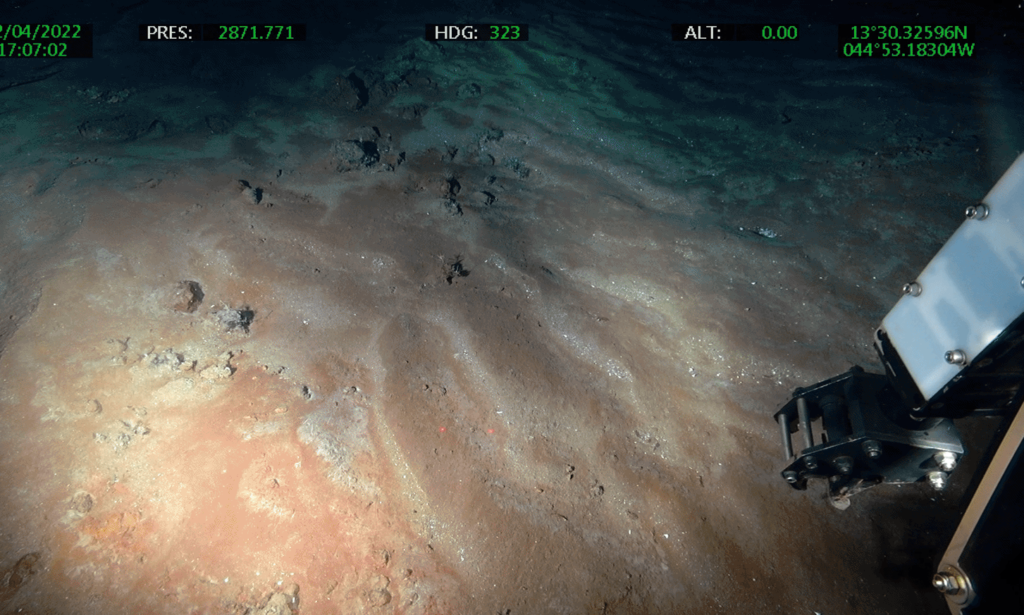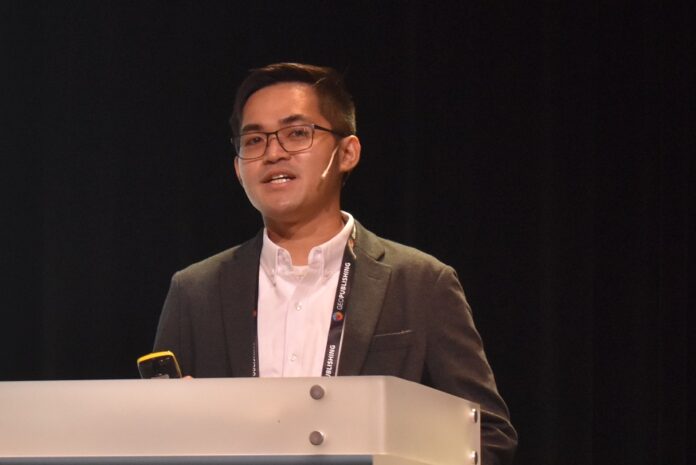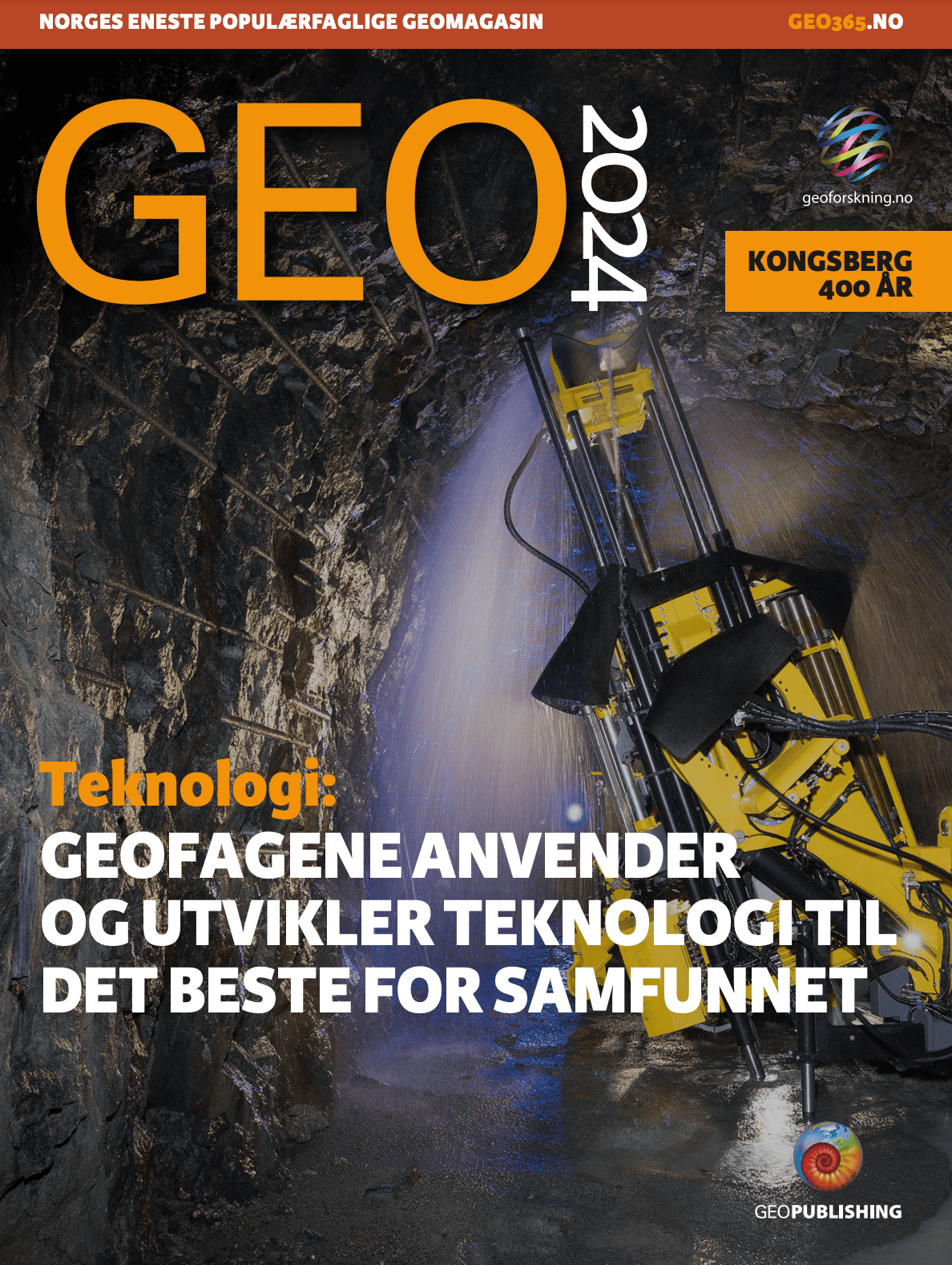PhD student Acer Figueroa explained how sediment mapping could be used as an exploration tool in the deep sea. Photo: Halfdan Carstens
– Metalliferous sediments are important deep-sea exploration markers, said Acer Figueroa, PhD student at the National Oceanography Centre (University of Southampton) during the Deep Sea Minerals 2022 conference in Bergen in October.
During his talk, Figueroa made the case that mapping these sediments may be a useful method for finding hidden seafloor massive sulphide (SMS) deposits.
SMS deposits are one of three types of deep-sea mineral occurrences which contain several of the metals that are required to succeed with the green shift, including copper, nickel, zinc, manganese and rare earth elements (REE).
SMS deposits are created at hydrothermal vent fields. The vents spew out boiling hot, mineral-rich water that cools down quickly when they encounter the low-temperature seawater. This leads to precipitation and accumulation of minerals. Some of the minerals precipitate below the seafloor.
Active hydrothermal fields can be located by identifying the plumes in the water column. Inactive fields are harder to locate as they no longer spew out water with detectable geochemical signatures. In addition, inactive vents are often buried by sediments.
geoforskning.no: The ore factories on the seabed
Still, in a resource and mining perspective, they are preferred over active hydrothermal vents as one avoid challenging high temperature fluids and disturbing vulnerable fauna.
The PhD student explained that metalliferous sediments are formed generally by two processes.
– They can be created by the fallout from hydrothermal plumes sourced from the vents. These plumes can travel far, and the sediments will typically be well sorted and fine-grained.
– They can also be created by mass wasting. These deposits are located close to the hydrothermal vents and are generally poorly sorted consisting of coarser grains.

Trends and tonnage
Figueroa presented some results from the research that he and his colleagues did when they went on a cruise to the Semenov hydrothermal field cluster on the Mid-Atlantic Ridge (13º30’N, approximately the same latitude as Senegal and Nicaragua) earlier this year as a part of the ULTRA project.
The project, which will return to the ridge next year, has and will collect a variety of data from the sites of mineralization, including drilling and coring, rock collecting, mapping the seafloor and using ocean bottom seismometers.
During the 2022 cruise, the scientists collected several sediment cores around the hydrothermal vent fields, in addition to mapping the bathymetry and using AUVs and ROVs.
A “quick and dirty” geochemical analysis was performed onboard, which revealed that there was a clear trend in the metal content in the metalliferous sediments.
– The cores closest to the hydrothermal vents displayed higher concentrations of certain metals, such as iron, zinc, lead and copper, Figueroa explained.
– It thus seems that mapping these sediments can be used as a method for locating nearby buried hydrothermal deposits.
He also pointed out that discovering mass wasting products within the sediments would be a good find, as they indicate that a deposit will be very close by.
– Mapping metalliferous sediments in a grid will give a spatial distribution of the metal content in the sediments that provide vectors to hidden deposits. It could be an important tool in the exploration toolbox.
Figueroa also said that his upcoming work will include dating the sediments. This will give insight into the longevity of a hydrothermal area.
– If we can determine how long a hydrothermal vent area has been active, then we will also know more about the potential tonnage of the deposit. Longer periods of hydrothermal activity typically yield larger deposits, Acer Figueroa concluded.
Partners in Project ULTRA includes the universities of Cardiff, Southampton, Leeds and the Memorial University (Canada), as well as GEOMAR (Germany). Norwegian project participants are the University of Bergen, Equinor and Green Minerals.
Remote detection
There are indeed several ways to Rome when it comes to exploration of SMS deposits. Recently, researchers at the University of Bergen demonstrated the use of self-potential as a geophysical measurement method that has worked well in identifying extinct (hidden) SMS deposits along the Mohn’s Ridge (geoforskning.no: En egnet letemetode – Expronews.com: A promising exploration method).
Self-potential (SP) is a measure of electrical voltage differences in rocks. Such stress differences can occur, for example, in rocks that contain conductive minerals and metals, including sulphides. This type of measurement can be performed in the deep sea using self-propelled and remote-controlled underwater robots (AUVs) equipped with sensors.



